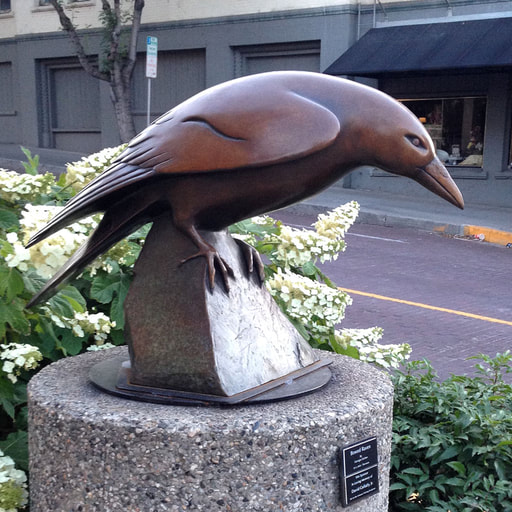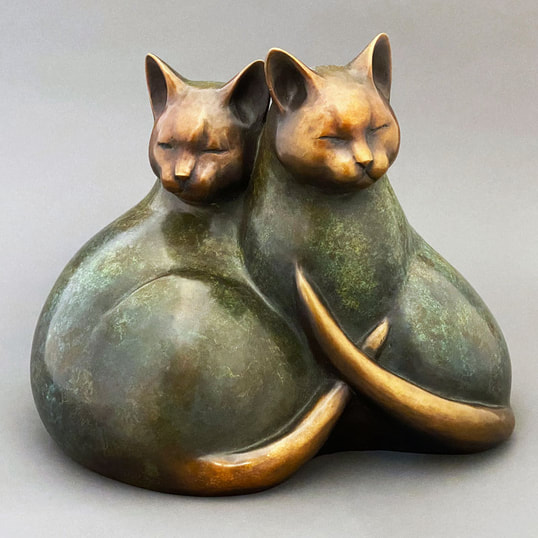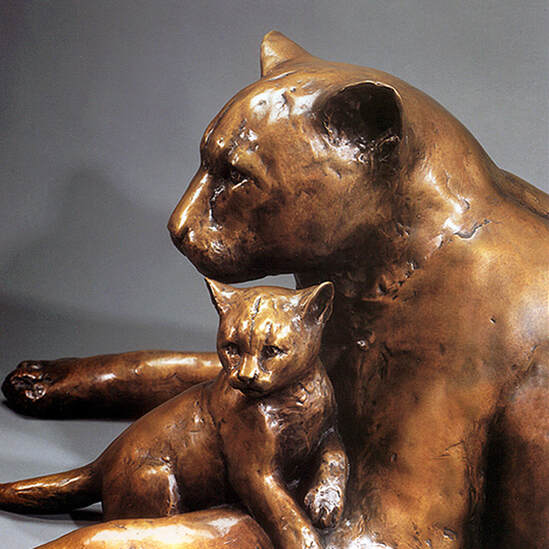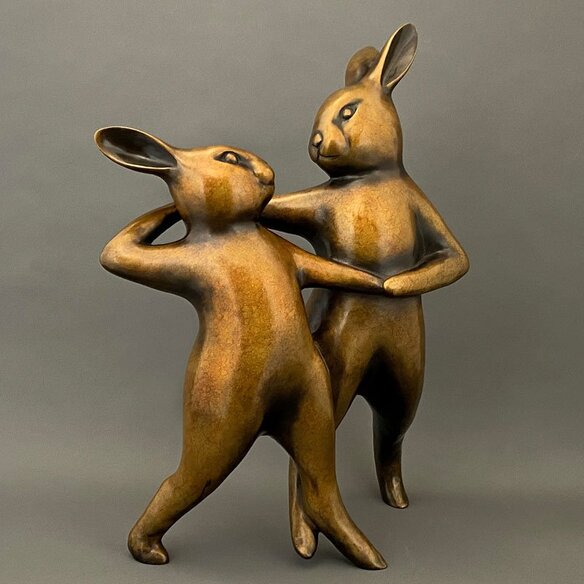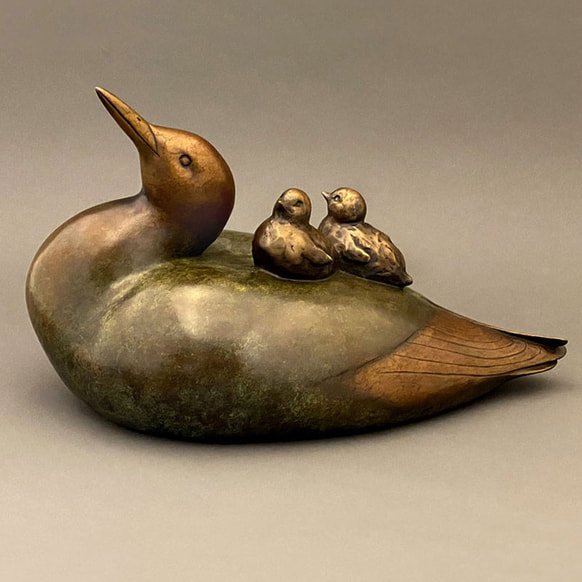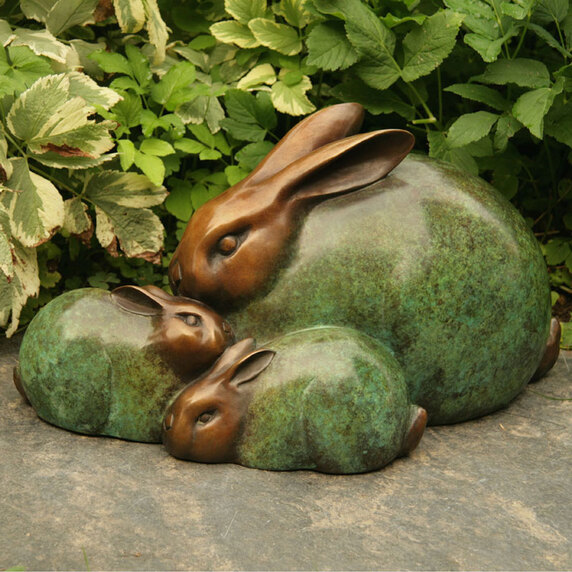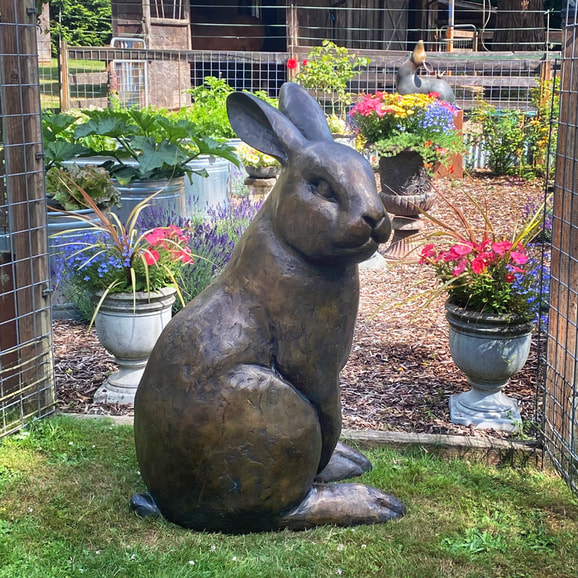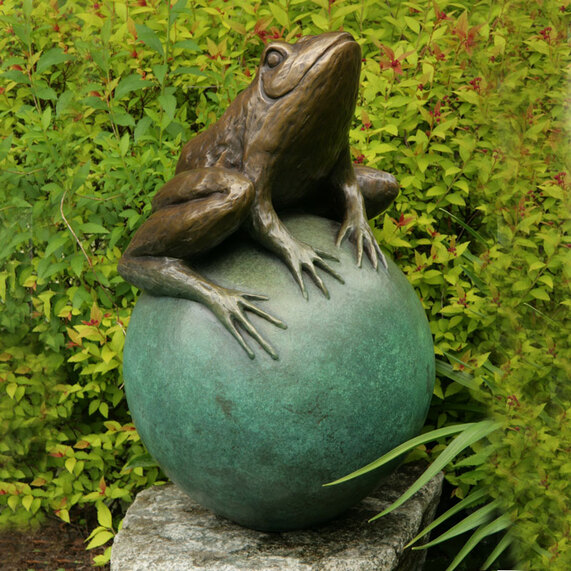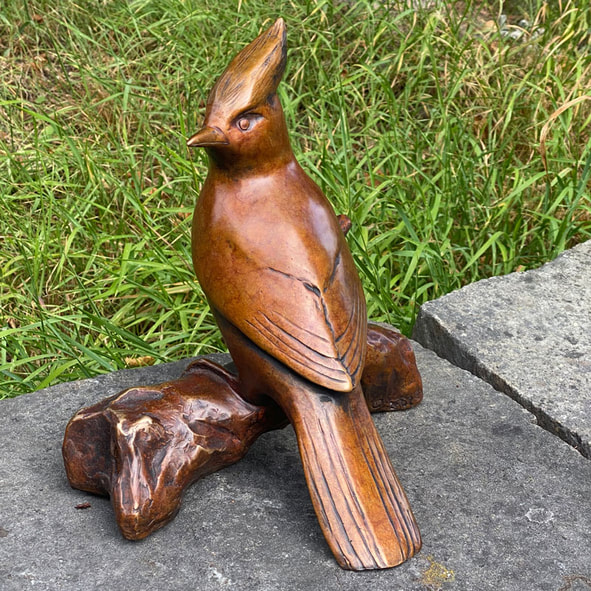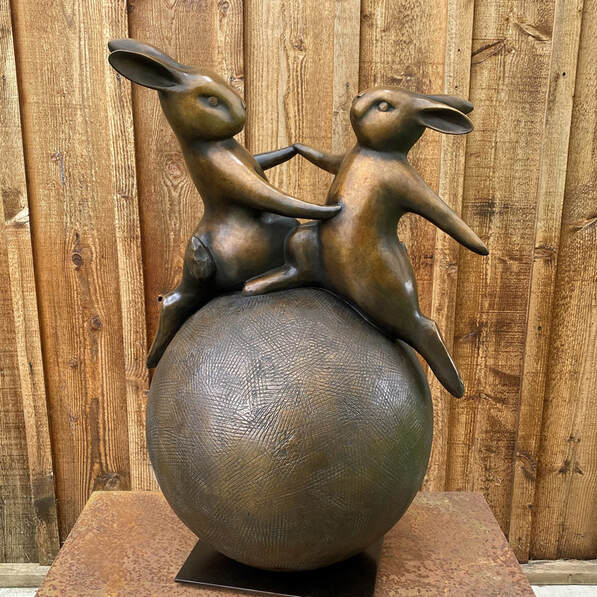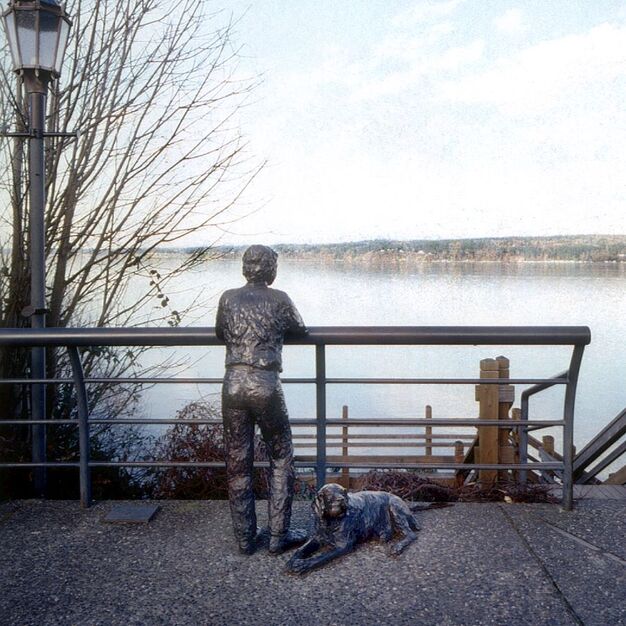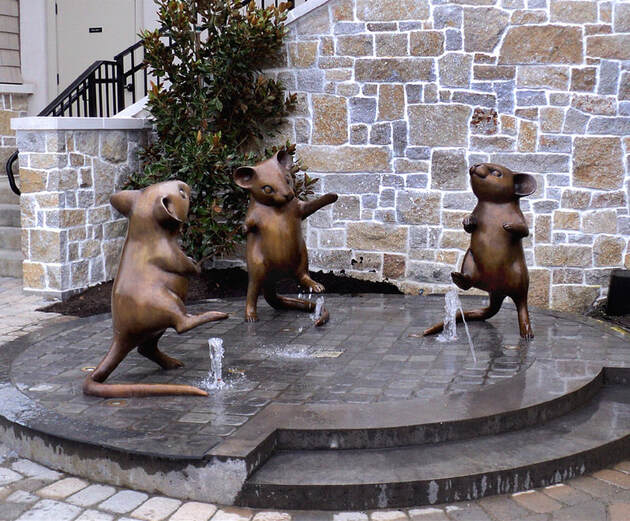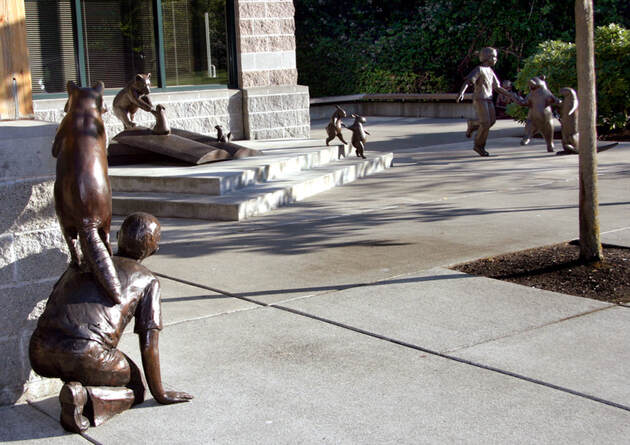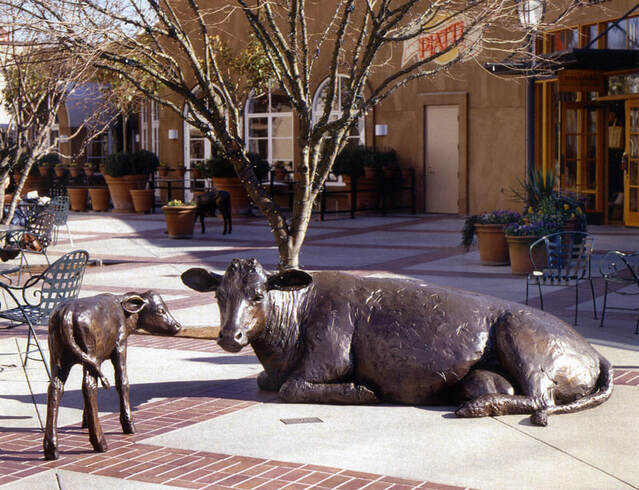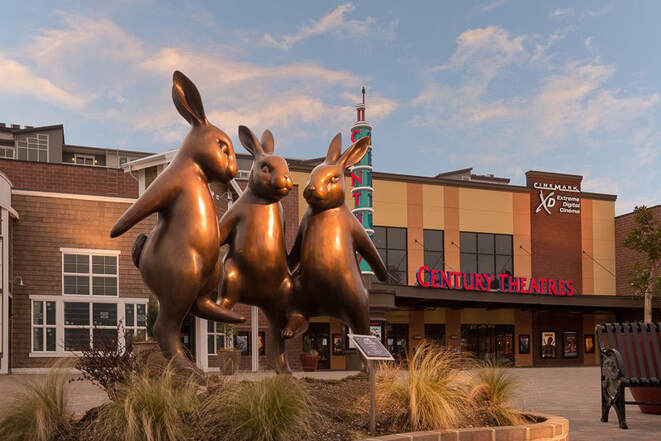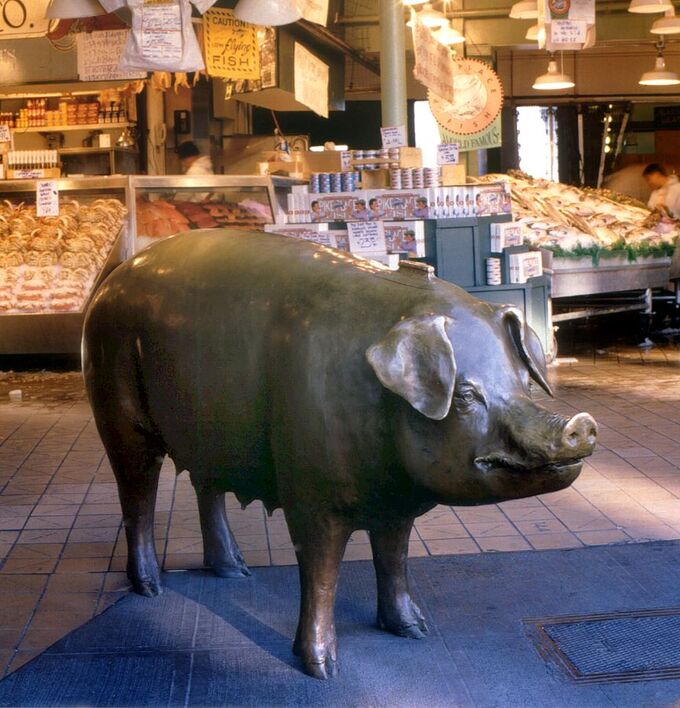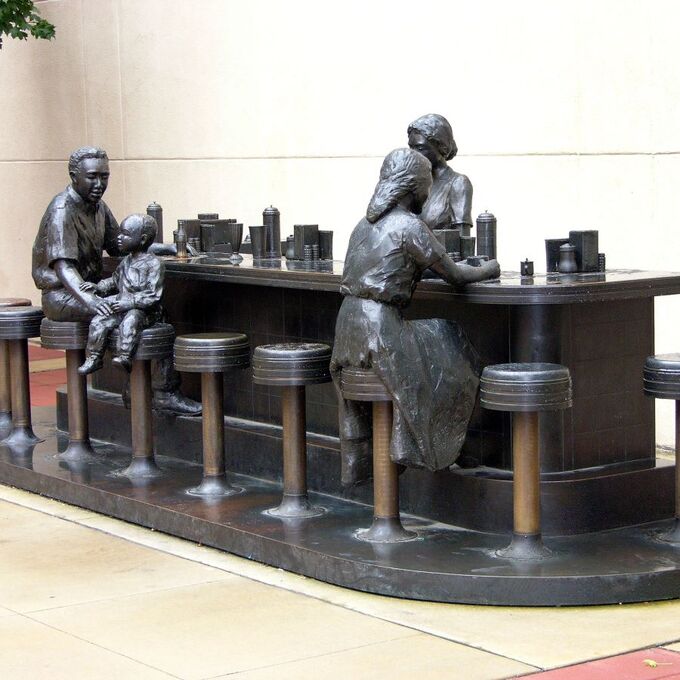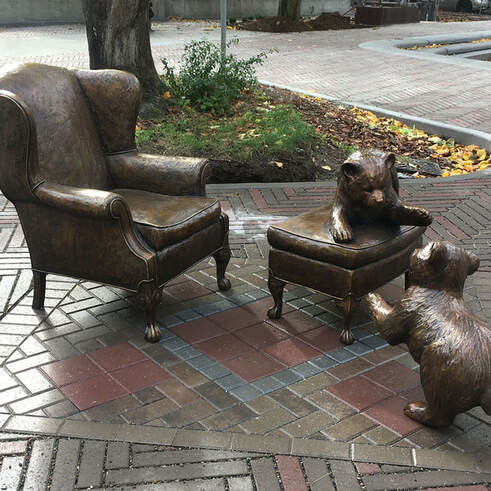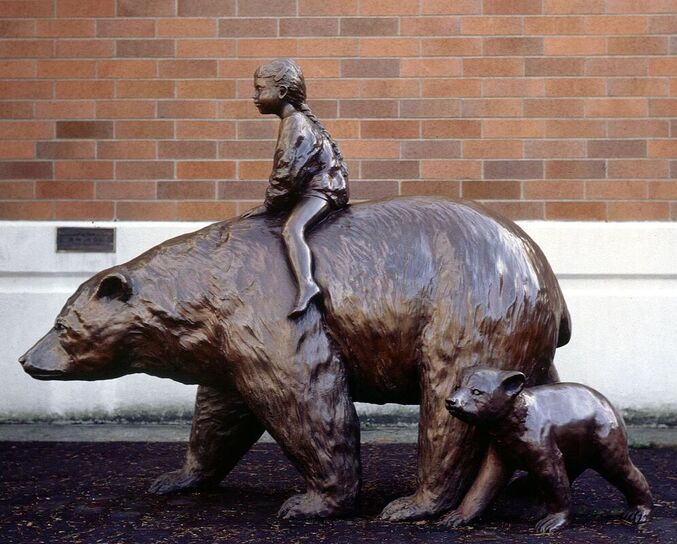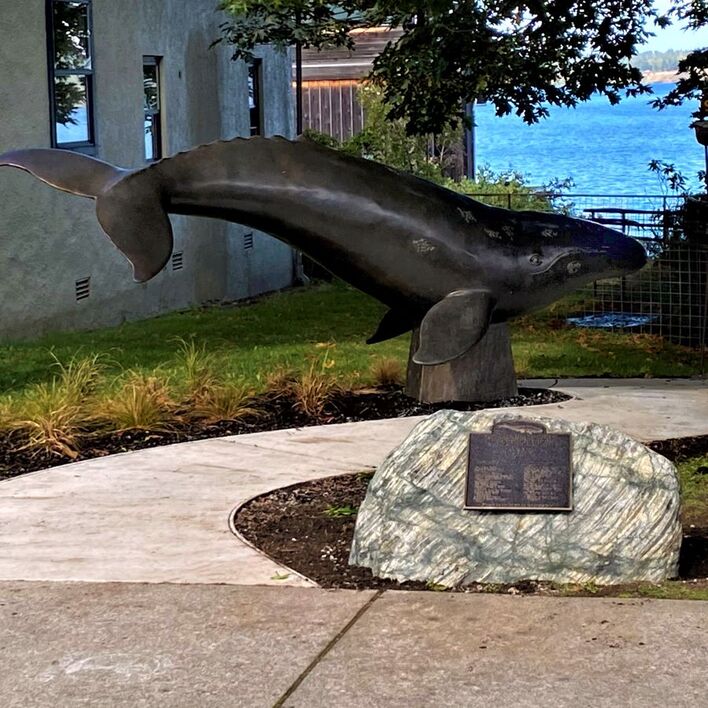Georgia Gerber
https://georgiagerber.com
[email protected]
(360) 661-2589
Bowed Raven
Bronze / 2013
Edition of 15
24”H x 37”W x 15”D
Bronze / 2013
Edition of 15
24”H x 37”W x 15”D
Cat Tales
Bronze / 2022
Edition of 25
13"H x 15W x 12"
Bronze / 2022
Edition of 25
13"H x 15W x 12"
Cougar with Cub
Bronze / 1995
Edition of 15
20"H x 75"W x 36"D
Bronze / 1995
Edition of 15
20"H x 75"W x 36"D
Georgia Gerber, born 1955, grew up in Chester County, Pennsylvania, studied sculpture and bronze casting at Bucknell University, and moved west to attend Graduate School at the University of Washington. Her professional career began at that time. She lives on rural Whidbey Island, Washington. For 35 years she operated her own studio and foundry with her husband, Randy Hudson, and assistant, Virginia Keck. Her daughter,
A career emphasis has been the creation of accessible public artwork that encourages viewer interaction. Georgia has primarily worked with life size animal and human figures, often incorporating architectural or abstract elements into the design.
ainter Laura Gerber Hudson, lives with her husband and three children a short walk down the road.
In 2004 Georgia began a relationship with Reinmuth Bronze Studio in Eugene, Oregon to help with casting, though her own crew continued pouring the majority of her sculpture. In 2018 the Gerber Foundry furnace was turned off for the last time and Reinmuth Bronze took on nearly all of the foundry work - though final finish and patina on much of her sculpture is still completed on Whidbey.
"My husband and I had our first date near the end of my graduate work at the University of Washington. That night I told him I dreamed of having my own studio and foundry in a quiet rural area where I could raise a family and create sculpture. We have been doing just that for many years now. What I didn't tell him was the part about the horses…" — Georgia Gerber
"I like my sculpture to invite an interaction with its audience. This is often meant to be a direct physical interaction, but always I strive to engage the viewer's imagination. I tend to present an incomplete visual narrative; a story is suggested, a feeling evoked, and the viewers find themselves providing details."
The following essay was submitted to the The Everett Herald for publication in their Fall 2020 Pacific Coast Magazine.
WHAT: It has taken me a long while to realize that I observe things differently than most people.
I see shapes and forms more than details and that’s what I focus on when sculpting. To me, it really shows in my work. In many of my pieces you could take away the parts that identify them as figurative and be left with a sort of abstract form that still works sculpturally. I think that is a lot of the attraction people have for my work – even if they don’t realize it.
I also love whimsy – which I think of as playful or fanciful rather than comical. There can be the whimsy of three girls dancing on a sidewalk, or a cow and calf at home in the middle of an urban shopping center that was once a dairy farm. But my most obviously whimsical sculptures have to be the series of Dancing Rabbits. I started long ago with a pair waltzing at the “Harvest Moon Ball” and have continued on with different dance poses every two or three years since. It’s a challenge to try and adapt animal anatomy to human movement, but the blending creates a whole other sort of visual whimsy on top of just the idea of them dancing.
I knew early on that I wanted to work life size, which can be very expensive to produce in bronze. So I learned how to cast my own work, which really helped build my career. We cast for about 35 years, but have now transitioned to partnering with Reinmuth Bronze in Eugene. I’m sure that knowing the difficulty and demands of the whole foundry process informs my sculpting style somewhat, not in any kind of a limiting way but in a way that makes the translation of clay into bronze more fluid.
I have always preferred my public work to be as accessible as possible. I like that people, especially children, can touch it and get involved with it. So whenever possible I place it directly in a site and seldom on pedestals.
WHEN: I grew up in Rural Pennsylvania riding horses and tending animals on our small farm with my twin sister. Back then we actually had art in high school and there was clay available and I found I enjoyed three dimensions. One of my first pieces was a little owl.
I came out West for the Master of Fine Arts program at the University of Washington. It was a difficult time for me because the sculpture department was not oriented toward the kind of figurative work I was doing. But in the end I think that was actually helpful since it forced me to explore different ways of thinking about sculpture and combining styles. I’m sure that lesson later inspired pieces like “Triad” for the Everett Library, with realistic but minimalized harbor seals cutting through three pillars that are architectural in nature but also somewhat natural looking.
I had a great undergrad professor William Lasansky. He not only taught me about form and line but about using tools and casting metal. He had a sensibility about quality and how it is evoked. It’s a certain look. It can be there, or not, in even just the roughness of your clay stroke. One of his most important gifts was helping me understand that a lot of times the real quality, the real art, is in knowing when to stop. He has always remained a strong influence. My husband still askes, “What would William say?” if I am struggling with a piece.
WHY: Making art brings me joy, and to think that my art brings joy to others seems to me about the best bargain ever made. The early years of trying to make a living were hard, and I did question my life choices at times. But somehow whenever it seemed nearly hopeless that call would come in from a gallery about a sale, or one of the seemingly endless applications for Public Art Commissions would actually end up with me being chosen. I am very grateful for all the support I have received.
There is a sculpture of mine in the nearby town of Langley of a teenage boy leaning against a railing and looking out over Saratoga Passage, with his dog waiting by his side. Randy and I sit in that little first street park sometimes and watch people interact with the piece. One time a tourist used broken English and motions to ask me to take a picture of him and his family gathered around the piece. If I ever wonder why I do what I do I’ll just go sit there on a busy day.
Retirement and what that might look like is a topic around our house these days. Like a lot of self-employed people we’re faced with how to wind things down after working so hard to get where we are. Not sure how that’s going to play out. I have grandkids so I am spending more time with them and slowing down with the studio work. I really get a kick out of being with them because any sculpture they see, whether it’s mine or not, they go, “Nana, did you make that?” They know Nana makes sculptures.
The reasons I became an artist haven’t changed and it is feeling like I will be growing old still exploring that creativity that has always driven me. But like of a lot other things I still love to do, it’s clearly going to have to be at a more leisurely pace.
HOW: I sculpt in oil based clay that never dries out – which is a lot more convenient than the natural clays I used to use. But to get from a completed clay work to a bronze sculpture there’s a whole lot of skilled foundry work that goes on. I have had wonderful assistants over the years, and Randy has been a huge part of making it all happen. He’s the foundry man, bookkeeper, photographer, mold maker, and so much more. He’s been what every artist needs in their lives to free them from all the necessary practicalities of this business. Sometimes his level headedness gets in the way though – while he does tolerate my having horses in our pasture, he nixed my proposal of life size bronze Stallions crashing through the second story wall for a casino in Reno. Go figure.
I have recently taken an interest in bird images. So in these pandemic days it’s mostly me and my birds in a quiet studio. I generally don’t listen to music because it distracts me from focusing on the piece. An exception was the three young girls dancing for “Along Colby “. I wanted the piece to have joy and rhythm and kept classical music on for a good deal of it.
The other part now is sharing all the ups and downs of developing an art career with my daughter as she establishes herself as a painter. It’s been wonderful to see her growth and be able to provide guidance. In return, her youthful excitement about new ideas and possibilities has been a good reminder and motivator for me after all these years.
A career emphasis has been the creation of accessible public artwork that encourages viewer interaction. Georgia has primarily worked with life size animal and human figures, often incorporating architectural or abstract elements into the design.
ainter Laura Gerber Hudson, lives with her husband and three children a short walk down the road.
In 2004 Georgia began a relationship with Reinmuth Bronze Studio in Eugene, Oregon to help with casting, though her own crew continued pouring the majority of her sculpture. In 2018 the Gerber Foundry furnace was turned off for the last time and Reinmuth Bronze took on nearly all of the foundry work - though final finish and patina on much of her sculpture is still completed on Whidbey.
"My husband and I had our first date near the end of my graduate work at the University of Washington. That night I told him I dreamed of having my own studio and foundry in a quiet rural area where I could raise a family and create sculpture. We have been doing just that for many years now. What I didn't tell him was the part about the horses…" — Georgia Gerber
"I like my sculpture to invite an interaction with its audience. This is often meant to be a direct physical interaction, but always I strive to engage the viewer's imagination. I tend to present an incomplete visual narrative; a story is suggested, a feeling evoked, and the viewers find themselves providing details."
The following essay was submitted to the The Everett Herald for publication in their Fall 2020 Pacific Coast Magazine.
WHAT: It has taken me a long while to realize that I observe things differently than most people.
I see shapes and forms more than details and that’s what I focus on when sculpting. To me, it really shows in my work. In many of my pieces you could take away the parts that identify them as figurative and be left with a sort of abstract form that still works sculpturally. I think that is a lot of the attraction people have for my work – even if they don’t realize it.
I also love whimsy – which I think of as playful or fanciful rather than comical. There can be the whimsy of three girls dancing on a sidewalk, or a cow and calf at home in the middle of an urban shopping center that was once a dairy farm. But my most obviously whimsical sculptures have to be the series of Dancing Rabbits. I started long ago with a pair waltzing at the “Harvest Moon Ball” and have continued on with different dance poses every two or three years since. It’s a challenge to try and adapt animal anatomy to human movement, but the blending creates a whole other sort of visual whimsy on top of just the idea of them dancing.
I knew early on that I wanted to work life size, which can be very expensive to produce in bronze. So I learned how to cast my own work, which really helped build my career. We cast for about 35 years, but have now transitioned to partnering with Reinmuth Bronze in Eugene. I’m sure that knowing the difficulty and demands of the whole foundry process informs my sculpting style somewhat, not in any kind of a limiting way but in a way that makes the translation of clay into bronze more fluid.
I have always preferred my public work to be as accessible as possible. I like that people, especially children, can touch it and get involved with it. So whenever possible I place it directly in a site and seldom on pedestals.
WHEN: I grew up in Rural Pennsylvania riding horses and tending animals on our small farm with my twin sister. Back then we actually had art in high school and there was clay available and I found I enjoyed three dimensions. One of my first pieces was a little owl.
I came out West for the Master of Fine Arts program at the University of Washington. It was a difficult time for me because the sculpture department was not oriented toward the kind of figurative work I was doing. But in the end I think that was actually helpful since it forced me to explore different ways of thinking about sculpture and combining styles. I’m sure that lesson later inspired pieces like “Triad” for the Everett Library, with realistic but minimalized harbor seals cutting through three pillars that are architectural in nature but also somewhat natural looking.
I had a great undergrad professor William Lasansky. He not only taught me about form and line but about using tools and casting metal. He had a sensibility about quality and how it is evoked. It’s a certain look. It can be there, or not, in even just the roughness of your clay stroke. One of his most important gifts was helping me understand that a lot of times the real quality, the real art, is in knowing when to stop. He has always remained a strong influence. My husband still askes, “What would William say?” if I am struggling with a piece.
WHY: Making art brings me joy, and to think that my art brings joy to others seems to me about the best bargain ever made. The early years of trying to make a living were hard, and I did question my life choices at times. But somehow whenever it seemed nearly hopeless that call would come in from a gallery about a sale, or one of the seemingly endless applications for Public Art Commissions would actually end up with me being chosen. I am very grateful for all the support I have received.
There is a sculpture of mine in the nearby town of Langley of a teenage boy leaning against a railing and looking out over Saratoga Passage, with his dog waiting by his side. Randy and I sit in that little first street park sometimes and watch people interact with the piece. One time a tourist used broken English and motions to ask me to take a picture of him and his family gathered around the piece. If I ever wonder why I do what I do I’ll just go sit there on a busy day.
Retirement and what that might look like is a topic around our house these days. Like a lot of self-employed people we’re faced with how to wind things down after working so hard to get where we are. Not sure how that’s going to play out. I have grandkids so I am spending more time with them and slowing down with the studio work. I really get a kick out of being with them because any sculpture they see, whether it’s mine or not, they go, “Nana, did you make that?” They know Nana makes sculptures.
The reasons I became an artist haven’t changed and it is feeling like I will be growing old still exploring that creativity that has always driven me. But like of a lot other things I still love to do, it’s clearly going to have to be at a more leisurely pace.
HOW: I sculpt in oil based clay that never dries out – which is a lot more convenient than the natural clays I used to use. But to get from a completed clay work to a bronze sculpture there’s a whole lot of skilled foundry work that goes on. I have had wonderful assistants over the years, and Randy has been a huge part of making it all happen. He’s the foundry man, bookkeeper, photographer, mold maker, and so much more. He’s been what every artist needs in their lives to free them from all the necessary practicalities of this business. Sometimes his level headedness gets in the way though – while he does tolerate my having horses in our pasture, he nixed my proposal of life size bronze Stallions crashing through the second story wall for a casino in Reno. Go figure.
I have recently taken an interest in bird images. So in these pandemic days it’s mostly me and my birds in a quiet studio. I generally don’t listen to music because it distracts me from focusing on the piece. An exception was the three young girls dancing for “Along Colby “. I wanted the piece to have joy and rhythm and kept classical music on for a good deal of it.
The other part now is sharing all the ups and downs of developing an art career with my daughter as she establishes herself as a painter. It’s been wonderful to see her growth and be able to provide guidance. In return, her youthful excitement about new ideas and possibilities has been a good reminder and motivator for me after all these years.
I Burn for You
Bronze / 2021
Edition of 25
23”H x 16”W x 7”D
Bronze / 2021
Edition of 25
23”H x 16”W x 7”D
Loon with Chicks
Bronze / 2022
Edition of 25
11"H x 19"W x 11"D
Bronze / 2022
Edition of 25
11"H x 19"W x 11"D
Rabbit with Kits
Bronze / 2018
Edition of 15
9"H x 17"W x 9"D
Bronze / 2018
Edition of 15
9"H x 17"W x 9"D
Snowshoe Hare (large)
Bronze / 2022
Edition of 25
53"H x 33"W x 20"D
Bronze / 2022
Edition of 25
53"H x 33"W x 20"D
Spring Song
Bronze / 2016
Edition of 15
29”H x 18”W x 18”D
Bronze / 2016
Edition of 15
29”H x 18”W x 18”D
Steller’s Jay
Bronze / 2022
Edition of 25
10"H x 10"W x 7"D
Bronze / 2022
Edition of 25
10"H x 10"W x 7"D
Tango Moon
Bronze / 2020
Edition of 25
32”H x 21”W x 18”D
Bronze / 2020
Edition of 25
32”H x 21”W x 18”D
Selected Public Art
Georgia Gerber has over 75 permanent public and corporate art installations throughout the United State and beyond. A more complete Gallery and additional photos can be found on her website https://georgiagerber.com/public-art
Georgia Gerber has over 75 permanent public and corporate art installations throughout the United State and beyond. A more complete Gallery and additional photos can be found on her website https://georgiagerber.com/public-art
Boy and Dog
First Street Park
Langey, Washington
1986
First Street Park
Langey, Washington
1986
Boys Night Out
Lynwood Center
Bainbridge Island, Washington
2012
Lynwood Center
Bainbridge Island, Washington
2012
Chapter 5: A Promise Kept
Children’s Library
Mukilteo, Washington
1999
Children’s Library
Mukilteo, Washington
1999
Coming home
University Village
Seattle, Washington
1995
University Village
Seattle, Washington
1995
Hip Hop
Point Ruston Center
Ruston, Washington
Point Ruston Center
Ruston, Washington
Rachel
Pike Place Market
Seattle, Washington
1986
Pike Place Market
Seattle, Washington
1986
Soda Fountain
Chester Lewis Reflection Park
Wichita, Kansas
2000
Chester Lewis Reflection Park
Wichita, Kansas
2000
Stimson Mansion Cubs
First Hill Park
Seattle, Washington
2021
First Hill Park
Seattle, Washington
2021
The Traveler
Mountlake Terrace Library
Mountlake Terrace, Washington
1988
Mountlake Terrace Library
Mountlake Terrace, Washington
1988
Wishing Whale
Whale Bell Park
Langley, Washington
2020
Whale Bell Park
Langley, Washington
2020

